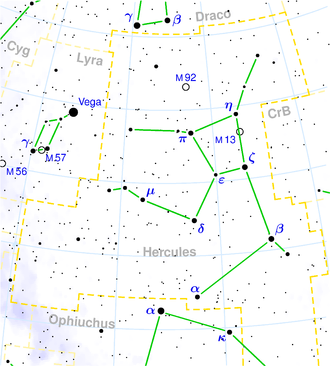Hercules dwarf galaxy
| Galaxy Hercules dwarf galaxy |
|
|---|---|

|
|
| Photo from the LBT (source: MPIA ). Field of view: 20 minutes of arc | |
| AladinLite | |
| Constellation | Hercules |
|
Position equinox : J2000.0 , epoch : J2000.0 |
|
| Right ascension | 16 h 13.0 m |
| declination | + 12 ° 47.5 ′ |
| Appearance | |
| Morphological type | dSph (Irr) |
| Brightness (visual) | 25.7 mag |
| Brightness (B-band) | 25.6 mag |
| Angular expansion | 15 ′ × 8 ′ |
| Physical data | |
| Affiliation | Local group , Milky Way subgroup |
| distance | galaktozentrisch: (430000 ± 40000) Lj / (132000 ± 12000) pc |
| diameter | 1800 ly |
| history | |
| discovery | International team |
| Discovery date | 2006 |
| Catalog names | |
The Hercules dwarf galaxy , also Hercules dSph , is a dwarf galaxy and a companion galaxy to the Milky Way at a galactocentric distance of approximately 430,000 light years . Her name is derived from her position as she is in the constellation Hercules .
In 2006, an international team of astronomers discovered the Hercules dwarf galaxy, a tiny companion of the Milky Way system, using data from the Sloan Digital Sky Survey . In 2007, further observations with the Large Binocular Telescope (LBT) followed in Arizona. The image of the Hercules dwarf galaxy was obtained using the Large Binocular Camera (LBC Blue) in the primary focus of one of the two mirrors.
properties
Almost all objects in the family of the smallest dwarf galaxies are round in shape. The Hercules dwarf galaxy, with an apparent brightness of approx. 25.5, may be extremely faint, but has the unusual appearance of a flat disc or a cigar . Similar to our Milky Way system, the stars in many large galaxies are distributed in a disk-like structure . In a small galaxy, similar to the Hercules dwarf galaxy, which despite its name only contains a ten millionth of the number of stars in our galaxy, a disk-like structure has never been observed before. Furthermore, none of the millions of well-studied galaxies were found with a cigar-like shape.
The cause of the unusual shape is the gravitational deformation caused by our Milky Way. The same effect can be observed in the Sagittarius dwarf galaxy , a satellite galaxy in our Milky Way system. Because of its orbit, the Hercules dwarf galaxy is extraordinarily close to the center of our Milky Way system.
"The Hercules dwarf galaxy is therefore either completely different from any of the millions of other galaxies studied so far, or it orbits our galaxy in an extreme orbit that almost plunges into the center."
additional
Web links
M. Coleman et al. Max Planck Institute for Astronomy - Report from September 14, 2007

